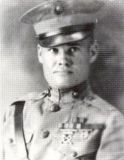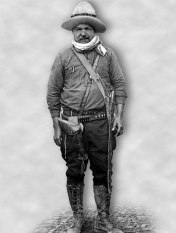(El Tigre goes to War—Again)
Over a period of nearly four decades active service, Lewis B. Puller became a legend in the U. S. Marine Corps. His comparatively short stature and barrel chest resulted in him gaining the nom de guerre “Chesty.” Over the span of his long career, Chesty Puller became one of the most highly decorated officers in the United States. He was awarded five (5) Navy Cross medals and the Army’s equivalent, the Distinguished Service Cross.
 Not long after the much-publicized Battle of Belleau Wood in July 1918, a young Lewy Puller enlisted in the Marines Corps, attending boot camp at Parris Island, South Carolina. The war was still on, and the Marine Corps was expanding. After graduating from boot camp, Puller attended NCO School, and after that, Officer’s Candidate School at Quantico, Virginia. World War I ended quite suddenly on 11 November 1918 and within a short time the Marines determined that they didn’t need as many officers as originally thought. A very disappointed Second Lieutenant Puller had two options: he could accept his discharge from the Marine Corps Reserve and go home, or he could reenlist in the Marines and serve as an enlisted man.
Not long after the much-publicized Battle of Belleau Wood in July 1918, a young Lewy Puller enlisted in the Marines Corps, attending boot camp at Parris Island, South Carolina. The war was still on, and the Marine Corps was expanding. After graduating from boot camp, Puller attended NCO School, and after that, Officer’s Candidate School at Quantico, Virginia. World War I ended quite suddenly on 11 November 1918 and within a short time the Marines determined that they didn’t need as many officers as originally thought. A very disappointed Second Lieutenant Puller had two options: he could accept his discharge from the Marine Corps Reserve and go home, or he could reenlist in the Marines and serve as an enlisted man.
It was thus that Corporal Puller began his long career as a battle-tested Marine and a combat leader. Puller would spend nearly ten years in the Marines before finally arriving in Nicaragua. Included in that time was service in Haiti as a lieutenant of the Gendarmerie d’Haiti[1]. While in Haiti, Puller participated in 40 combat engagements against the Caco rebels. By the time he arrived in Nicaragua as a Marine Corps Second Lieutenant, Puller had already become a hardened combat veteran and had earned for himself the reputation of a man consistently demonstrated courage and coolness under fire.
Puller arrived in Nicaragua in early December 1928; he was surprised (perhaps disappointed would be a more appropriate word) to learn that he would be assigned the Personnel Officer at Guardia headquarters. It wasn’t his first staff assignment, of course, as Puller previously served as Adjutant in Haiti and at the Norfolk Naval Base —what he wanted, however, was a combat assignment.
Nevertheless, Guardia headquarters needed a good personnel officer because in one six-month period in 1928, the Marine Corps transferred out 31 NCOs judged to be unsuitable for “detached” duties. Personnel turbulence detracts from unit efficiency and esprit-de-corps, and so too did the bureaucratic practices of the Guardia Nacional: all post-operational combat reports had to be filed in quadruplicate. To Puller, it seemed as if the Marines were obsessed with paperwork —a notion he would carry with him into the future— but archived records did allow the Marine Corps to develop their Small Wars Manual in years to come. Whatever Puller thought about his staff assignment, he performed his duties to the best of his ability and was rated very high by the Director (jefe) of the Guardia Nacional.
Within only a few months, Puller took command of the Guardia garrison at Corinto, the major seaport on the West Coast of Nicaragua. Policing a large town was no simple task, especially considering that the civil populace was engaged in civil war. Puller did well enough to earn his promotion to Marine Corps First Lieutenant in May 1929; he was advanced in rank to Guardia Captain almost at the same time. As a captain, he was too senior to command such a small garrison force as that at Corinto, so Puller was ordered back to Managua to command the Guard Force at the national penitentiary. He served in this post for about one-week before receiving another set of orders, this time assigning him to the First Battalion at Jinotega.
 Ultimately, Puller’s responsibility would include both Jinotega and Matagalpa … the latter being a small city at the juncture of two rivers. The principal economic activities in this region included cattle raising and coffee growing. Nicaraguan ranches were called fincas. Marine aviators maintained an airstrip four-miles to the north. To the west was the Northern Area, which included Nueva Segovia and Esteli. It was the principal operating area of Augusto César Sandino and his compadres … which included Pedro Altamirano (called Pedrón) (shown left) —one of the most powerful and ruthless Sandinista generals. Even in Nicaragua, where the execution of opponents was ritualized, the behavior of Pedrón was considered particularly despicable. He had sufficient guile to avoid battle when he did not have the upper hand, was an expert in using Nicaragua’s jungle to his own advantage, and whenever he did decide to fight, he was a brutal adversary.
Ultimately, Puller’s responsibility would include both Jinotega and Matagalpa … the latter being a small city at the juncture of two rivers. The principal economic activities in this region included cattle raising and coffee growing. Nicaraguan ranches were called fincas. Marine aviators maintained an airstrip four-miles to the north. To the west was the Northern Area, which included Nueva Segovia and Esteli. It was the principal operating area of Augusto César Sandino and his compadres … which included Pedro Altamirano (called Pedrón) (shown left) —one of the most powerful and ruthless Sandinista generals. Even in Nicaragua, where the execution of opponents was ritualized, the behavior of Pedrón was considered particularly despicable. He had sufficient guile to avoid battle when he did not have the upper hand, was an expert in using Nicaragua’s jungle to his own advantage, and whenever he did decide to fight, he was a brutal adversary.
Puller’s first operation (July) involved a force of four patrols (5 officers, 80 troops). Moving northward on a parallel course, the patrols swept the area for bandits. They saw no significant action in the eleven days in the field, their only success being a bandit storehouse, which they set afire. The following month, sixty bandits launched a night raid on the town of Jicaro; there were several waves, but each one was met with devastating automatic weapons fire. When the bandits finally withdrew, the Guardia pursued them for several hours, but no trace of the enemy or their casualties were found.
(To be continued next week)
Notes:
[1] Marine Corps NCOs received officer’s commissions in the Gendarmerie d’Haiti, enabling these Marines to assume command of Haitian platoons and companies. Marine officers (Captains and Majors) served in a similar capacity, receiving appointments to senior officer Gendarmerie positions

I’ve got to share this with some friends!!
LikeLike
Thank you so much …
LikeLiked by 1 person
Couldn’t comment this on the last post:
Nation building at it’s finest.
LikeLike
As an aside, I should probably mention that Americans have been involved in “nation building” since 1776; one might argue that we haven’t mastered this for our own country let alone the nations of others. Perhaps the issue is far too complex for our limited capacity minds; we are incapable of understanding the values of other cultures.
Nevertheless, to the extent that US diplomats had good reason to fear European encroachment into the affairs of the Americas —most of which was the fault of savage-minded caudillos, there was little other choice but to do some “nation-building.” And if we can agree that this is true, it then becomes a matter of putting into place the kinds of people stern enough to deliver the goods. The essential tasks of the Marines in Nicaragua were two: first, destroy the rebels who threatened a duly elected government; next, dismantle the army and replace it with a national constabulary whose loyalty belongs to the national constitution rather than to the person of a temporary president.
LikeLike
When half the population are insurgents, it could get bad.
LikeLike
In many ways, Nicaragua was a feudal society several rungs below the ladder of European feudal civilizations. When combined with Latino machismo, or for the lack of a better term, exaggerated masculinity, then the result was (and I suspect still is) that strong-man want-to-be’s competed with one another over who should control large tracts of Nicaraguan wilderness. While horrifyingly ruthless toward unarmed peons, these caudillos were quite out-matched by the strongest tribe of all: American Marines. Culturally, they couldn’t deal with this fact without being severely mauled by the Marines, which of course they were.
These Central American bandits remind me of the Arab warrior (their de facto distant cousin) in the sense that they would launch an ambuscade, suffer the consequences of attacking a far superior force, and then run away. Later, they would all sit around the camp fire and regale one another about such great displays of their courage in battle. It was nothing if not Don Quixotesque.
As we shall see, political decisions in Washington ultimately determined how effective these Marines were in the so-called Banana Wars. The American government has never shown a willingness to stay the course in a conflict it initiated —a fact which is well-known throughout the world, and which, in my opinion, works against our long-term national interests. We Americans seem incapable of learning important lessons from history …
LikeLike
as always- wonderful historical insight – thank you
LikeLike
Thank you, Carol …
LikeLike